Diana Ross
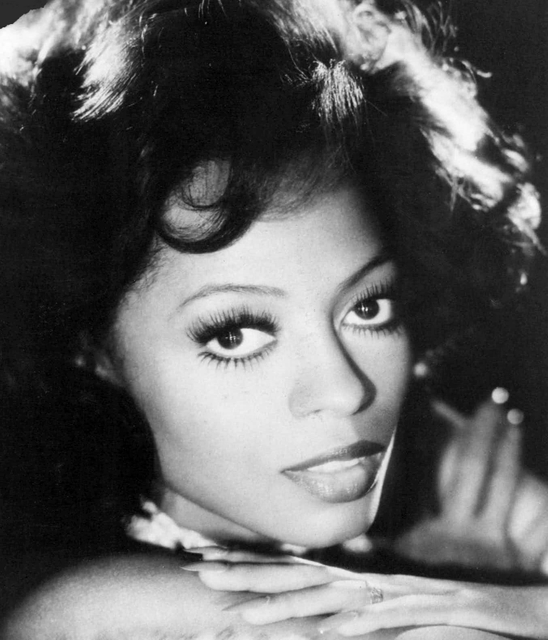
Diana Ross

Diana Ross | |
|---|---|
| Born | Diana Ross (1944-03-26)March 26, 1944 Detroit, Michigan, U.S. |
| Residence | Greenwich, Connecticut, U.S. Los Angeles, California, U.S. |
| Occupation |
|
| Years active | 1959 - present |
| Spouse(s) | Robert Ellis Silberstein (m. 1971;div. 1977) |
| Children | 5, including: Rhonda Ross Kendrick Tracee Ellis Ross Evan Ross |
| Musical career | |
| Genres | |
| Instruments |
|
| Labels | |
| Associated acts |
|
Diana Ross (born March 26, 1944) is an American singer, actress, and record producer. Born and raised in Detroit, Michigan, Ross rose to fame as the lead singer of the vocal group the Supremes, which, during the 1960s, became Motown's most successful act, and are the best charting girl group in US history,[1] as well as one of the world's best-selling girl groups of all time. The group released a record-setting twelve number-one hit singles on the US Billboard Hot 100, including "Where Did Our Love Go", "Baby Love", "Come See About Me", "Stop! In the Name of Love", "You Can't Hurry Love", "You Keep Me Hangin' On", "Love Child", and "Someday We'll Be Together".
Following her departure from the Supremes in 1970, Ross released her eponymous debut solo album that same year, featuring the number-one Pop hit "Ain't No Mountain High Enough". She later released the album Touch Me in the Morning in 1973; its title track reached number 1, as her second solo No. 1 hit. She continued a successful solo career through the 1970s, which included hit albums like Mahogany and Diana Ross and their number-one hit singles, "Theme from Mahogany" and "Love Hangover", respectively. Her 1980 album Diana produced another number-one single, "Upside Down", as well as the international hit "I'm Coming Out". Ross' final single with Motown during her initial run with the company achieved her sixth and final US number-one Pop hit, the duet "Endless Love" featuring Lionel Richie, whose solo career was launched with its success.
Ross has also ventured into acting, with a Golden Globe Award and Academy Award-nominated performance for her performance in the film Lady Sings the Blues (1972); she recorded its soundtrack, which became a number-one hit. She also starred in two other feature films, Mahogany (1975) and The Wiz (1978), later acting in the television films Out of Darkness (1994), for which she also was nominated for a Golden Globe Award, and Double Platinum (1999).
Ross was named the "Female Entertainer of the Century" by Billboard magazine. In 1993, the Guinness Book of World Records declared Ross the most successful female music artist in history, due to her success in the United States and United Kingdom for having more hits than any female artist in the charts, with a career total of 70 hit singles with her work with the Supremes and as a solo artist. In 1988, Ross was inducted to the Rock and Roll Hall of Fame as member of the Supremes, alongside Mary Wilson and Florence Ballard. She was the recipient of the Kennedy Center Honors in 2007, and the Presidential Medal of Freedom in 2016.
She is a 12-time Grammy nominee, never earning a competitive honor, but later became the recipient of the Grammy Lifetime Achievement Award in 2012.[2] In December 2016, Billboard magazine named her the 50th most successful dance artist of all time.[3] In Billboard magazine's Greatest of All Time Hot 100 Artists chart, she ranked 16th as the lead singer of the Supremes and 26th as a solo artist. In December 2018, Diana Ross consolidated her status as a dance diva by ranking #3 in the Billboard Dance Club Songs Artists year-end chart.[4]
Diana Ross | |
|---|---|
| Born | Diana Ross (1944-03-26)March 26, 1944 Detroit, Michigan, U.S. |
| Residence | Greenwich, Connecticut, U.S. Los Angeles, California, U.S. |
| Occupation |
|
| Years active | 1959 - present |
| Spouse(s) | Robert Ellis Silberstein (m. 1971;div. 1977) |
| Children | 5, including: Rhonda Ross Kendrick Tracee Ellis Ross Evan Ross |
| Musical career | |
| Genres | |
| Instruments |
|
| Labels | |
| Associated acts |
|
Early life

The building that was part of the Brewster-Douglass Housing Projects in Detroit, where Diana spent her teenage years
According to Ross, her mother actually named her "Diane", but, a clerical error resulted in her name being recorded as "Diana" on her birth certificate. She was listed as "Diane" during the first Supremes records, and she introduced herself as "Diane" until early in the group's heyday. Her friends and family still call her "Diane".[7][8]
Ross's grandfather John E. Ross, a native of Gloucester County, Virginia, was born to Washington Ross and Virginia Baytop. Virginia Baytop's mother Francis "Frankey" Baytop was a former slave who had become a midwife after the Civil War.
Ross and her family originally lived on Belmont Road in the North End section of Detroit, near Highland Park, Michigan, where her neighbor was Smokey Robinson. When Ross was seven, her mother contracted tuberculosis, causing her to become seriously ill. Ross's father moved with his children to live with relatives in Bessemer, Alabama. After her mother recovered, her family moved back to Detroit.[9]
On her 14th birthday in 1958, her family relocated to the working-class Brewster-Douglass Housing Projects settling at St. Antoine Street. Attending Cass Technical High School,[10] a four-year college and preparatory magnet school, in downtown Detroit, Ross began taking classes including clothing design, millinery, pattern making, and tailoring, as she had aspired to become a fashion designer. She also took modeling and cosmetology classes at the school and participated in three or four other extracurricular activities while there.
Ross also worked at Hudson's Department Store where it has been claimed in biographies, she was the first black employee "allowed outside the kitchen".[11] For extra income, she provided hairdressing services for her neighbors. Ross graduated from Cass Tech in January 1962.
Career
The Supremes: 1959–1970
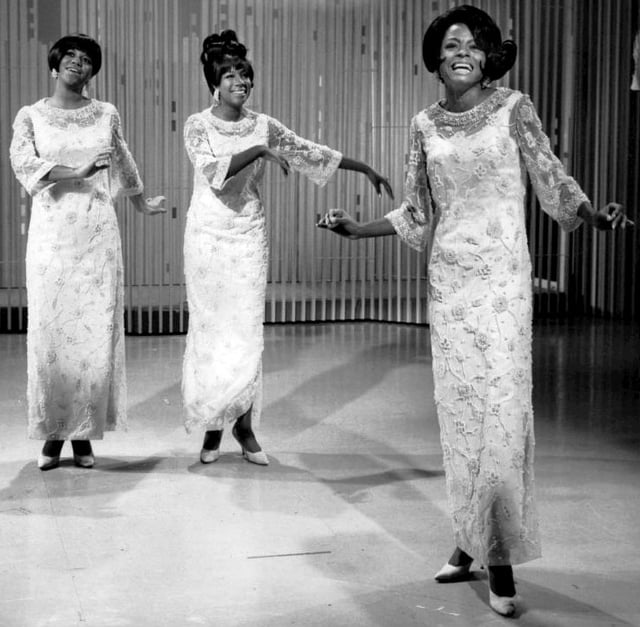
Ross (far right) performing with the Supremes as lead singer
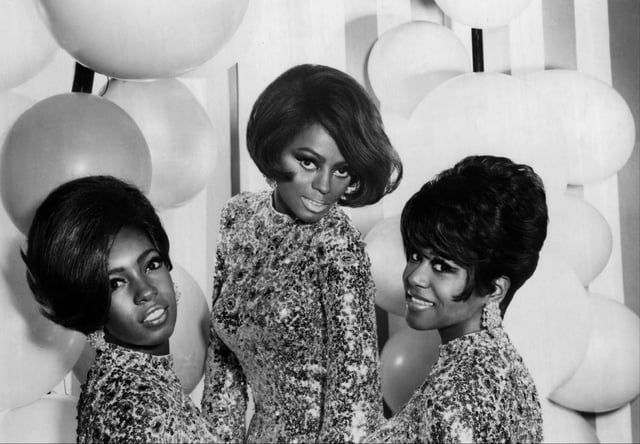
Ross with the Supremes in 1967
At fifteen, Ross joined the Primettes, a sister group of a male vocal group called the Primes, after being brought to the attention of music manager Milton Jenkins by Primes member Paul Williams. Along with Ross, the other members included Florence Ballard, the first group member hired by Jenkins, Mary Wilson, and Betty McGlown. Following a talent competition win in Windsor, Ontario, in 1960, the Primettes were invited to audition for Motown records.
Later, following local success via live performances at sock hops, etc., Ross approached former neighbor (and rumored childhood former boyfriend), William "Smokey" Robinson, who insisted that the group audition for him first. Robinson agreed to bring the Primettes to Motown, in exchange for letting him and the Miracles hire the Primettes' guitarist, Marv Tarplin, for an upcoming tour. Tarplin played in Robinson's band(s) for the next 30-plus years.
In her autobiography, "Secrets of a Sparrow", Ross wrote that she felt that deal was "a fair trade". The Primettes later auditioned for Motown Records, before various Motown executives. In Berry Gordy's autobiography, To Be Loved, Gordy recalled he was heading to a business meeting when he heard Ross singing "There Goes My Baby" and Ross's voice "stopped me in my tracks". He approached the group and asked them to perform it again but, learning of their ages, Gordy advised them to come back after graduating from high school.[12]
Undeterred, the group went to Motown's Hitsville U.S.A. headquarters regularly, offering to provide extra help for Motown's recordings, often including hand claps and background vocals. That year, the group recorded two tracks for Lu Pine Records, with Ross singing lead on one of the tracks. During the group's early years, Ross served as hair stylist, make-up artist, seamstress, and costume designer. In late 1960, having replaced McGlown with Barbara Martin, the Primettes were allowed to record their own songs at Hitsville's studio, many written by "Smokey" Robinson, who, by then, was vice president of Motown ("Your Heart Belongs to Me" and "A Breathtaking Guy"). Gordy, too, composed songs for the trio, including "Buttered Popcorn" (featuring Ballard on lead) and "Let Me Go the Right Way". While these songs were regional hits, they were not nationwide successes.
In January 1961, Gordy agreed to sign the group on the condition they change their name. Eventually, Janie Bradford approached Florence Ballard, the only group member at the studio at the time, to pick out a new name for the group. Ballard chose "Supremes", reportedly, because it was the only name on the list that did not end with "ette". Upon hearing the new name, the other members weren't impressed, with Ross telling Ballard she feared the group would be mistaken for a male vocal group (a male vocal group was, indeed, named the Supremes). Gordy signed the group under their name on January 15, 1962.
A year later, Barbara Martin left the group, reducing the quartet to a trio. In late 1963, the group had their first hit with "When the Lovelight Starts Shining Through His Eyes", peaking at number 23 on the Billboard Hot 100 pop chart. At the end of the year, Gordy assigned Ross as the group's lead singer, even though Ballard was usually the lead vocalist.
The group scored their first number-one hit with "Where Did Our Love Go", paving the way for unprecedented success: between August 1964 and May 1967, Ross, Wilson, and Ballard sang on ten number-one hit singles, all of which also made the UK top 40.[12] The group had also become a hit with audiences both domestically and abroad, going on to become Motown's most successful vocal act throughout the sixties. Following significant issues with her comportment, weight, and alcoholism, Florence Ballard was fired from the Supremes by Gordy in July 1967, hiring Cindy Birdsong from Patti LaBelle and the Blue-Bells as Ballard's replacement.
Gordy renamed the group Diana Ross & the Supremes, making it easier to charge a larger performance fee for a solo star and a backing group, as it did for other renamed Motown groups. Gordy initially considered Ross leaving the Supremes for a solo career in 1966 but changed his mind because the group's success was still too significant for Ross to pursue solo obligations. Ross remained with the Supremes until early 1970.
As the lead voice of the Supremes, she was really only the soul—or perhaps élan vital—of a machine, ready to plug into whatever arrangement, lyric, or show dress Berry Gordy and the Motown organization provided. She sang of the pain of love without appearing to suffer, but that doesn't mean that the catch-phrases—'You keep me hanging on,' 'Where did our love go?' 'Love is like an itching in my heart, and I can't scratch it'—were softened or somehow corrupted. Instead, they were transcended with the vivacity that is Diana Ross' great gift. No matter how she is stylized, no matter what phony truism she mouths, this woman always lets you know she is alive. — Robert Christgau, 1973[13]
The group appeared as a trio of singing nuns in a 1968 episode of the popular NBC TV series Tarzan. Between their early 1968 single "Forever Came Today" and their final single with Ross, "Someday We'll Be Together", Ross would be the only Supremes member to be featured on many of their recordings, often accompanied by session singers the Andantes or, as in the case of "Someday, We'll Be Together", Julia and Maxine Waters and Johnny Bristol.[14] Still, Wilson and Birdsong continued to sing on recordings.
Gordy, drove Ross diligently throughout this period and Ross, due to anxiety arising from Gordy's demands of her, began suffering from anorexia nervosa, according to her autobiography, Secrets of a Sparrow. During a 1967 performance in Boston, Massachusetts, Ross collapsed onstage, and had to be hospitalized for exhaustion.
In 1968, Ross began to perform as a solo artist on television specials, including the Supremes' own specials such as TCB and G.I.T. on Broadway, The Dinah Shore Show, and a Bob Hope special, among others. In mid-1969, Gordy decided that Ross would depart the group by the end of that year, and Ross began recording her initial solo work that July. One of the first plans for Ross to establish her own solo career was to publicly introduce a new Motown recording act.
Though she herself did not claim their discovery, Motown's publicity department credited Ross with having discovered the Jackson 5. Ross would introduce the group during several public events, including The Hollywood Palace.[15] In November, Ross confirmed a split from the Supremes in Billboard. Ross' presumed first solo recording, "Someday We'll Be Together", was eventually released as a Supremes recording and became the group's final number-one hit on the Hot 100. It was also the final number-one Billboard Hot 100 single of the 1960s. Ross made her final appearance with the Supremes at the Frontier Hotel in Las Vegas, Nevada on January 14, 1970.
Solo career, Touch Me in the Morning, Duets album, Lady Sings the Blues soundtrack and diana: 1970–1981
In May 1970, Ross released her eponymous solo debut, which included her signature songs, "Reach Out and Touch (Somebody's Hand)" and "Ain't No Mountain High Enough", the latter becoming Ross' first number-one solo single. Follow-up albums, Everything Is Everything and Surrender came out shortly afterwards. In 1971, the ballad "I'm Still Waiting" became her first number-one single in the UK. Later in 1971, Ross starred in her first solo television special, Diana!, which included the Jackson 5.
In 1972, the soundtrack to her film debut, Lady Sings the Blues, reached number one on the Billboard 200, selling two million units. In 1973, Ross had her second number-one hit with the ballad "Touch Me in the Morning". Later in the year, Motown issued Diana & Marvin, a duet album with fellow Motown artist Marvin Gaye. The album became an international hit. Touring throughout 1973, Ross became the first entertainer in Japan's history to receive an invitation to the Imperial Palace for a private audience with the Empress Nagako, wife of Emperor Hirohito.[16]
In April 1974, Ross became the first African-American woman to co-host the 46th Academy Awards, with John Huston, Burt Reynolds, and David Niven.
After the release of a modestly successful LP, Last Time I Saw Him, Ross had a third number-one hit with "Theme from Mahogany (Do You Know Where You're Going To)", from her second feature film, Mahogany. A year later, in 1976, Ross released her fourth solo number-one hit, "Love Hangover", a sensual, dramatic mid-tempo song that bursts into an uptempo disco tune. Later that year, Ross launched her "An Evening with Diana Ross" tour. The tour's success led to a two-week stint at Broadway's Palace Theatre and a 90-minute, Emmy-nominated television special of the same name, featuring special make-up effects by Stan Winston, for a scene in which Ross portrayed legendary cabaret artist Josephine Baker and blues singers Bessie Smith and Ethel Waters,[17] and a Special Tony Award.[18]
The albums Baby It's Me and Ross sold modestly. In 1979, Ross released The Boss, continuing her popularity with dance audiences, as the title song became a number-one dance single. On July 16, 1979, Ross guest-hosted an episode of Johnny Carson's The Tonight Show, featuring Lynda Carter, George Carlin, and Muhammad Ali as guests.[19] Later that year, Ross hosted the HBO special, Standing Room Only, filmed at Caesar's Palace's Circus Maximus Theater in Las Vegas, Nevada, during her "Tour '79" concert tour.[20] This concert special is noted for its opening, during which Ross literally makes her entrance through a movie screen. In November of that year, Ross performed The Boss album's title track as a featured artist during the Macy's Thanksgiving Day Parade, in New York City.[21]
In 1980, Ross released her most successful album to date, Diana. Composed by Chic's Nile Rodgers and Bernard Edwards, the album included the hits "I'm Coming Out" and "Upside Down", the latter becoming her fifth chart-topping single. Prior to leaving Motown, Ross recorded the duet ballad "Endless Love", with Lionel Richie. The song would become her sixth and final single to reach number one on the Billboard Hot 100.
Ross began negotiations to leave Motown at the end of 1980. After over 20 years with the label, Ross received US$250,000 as severance. RCA Records offered Ross a $20 million, seven-year recording contract, which gave her complete production control of her albums. Allegedly, before signing onto the label, Ross asked Berry Gordy if he could match RCA's offer. Gordy stated that doing so was "impossible". Ross then signed with RCA on May 20, 1981. At the time, Ross's was music history's most expensive recording deal.
Film career: 1972–1999
In 1971, Diana Ross began working on her first film, Lady Sings the Blues, which was a loosely based biography on singer Billie Holiday. Despite some criticism of her for taking the role, once the film opened in October 1972, Ross won critical acclaim for her performance in the film. Jazz critic Leonard Feather, a friend of Holiday's, praised Ross for "expertly capturing the essence of Lady Day". Ross's role in the film won her Golden Globe Award and Academy Award nominations for Best Actress. The soundtrack to Lady Sings the Blues became just as successful, reaching No. 1 on the Billboard 200 staying there for two weeks.
Ross's second film, Mahogany, was released in 1975. The film reunited her with Billy Dee Williams, her co-star in Lady Sings the Blues and featured costumes designed by Ross herself. The story of an aspiring fashion designer who becomes a runway model and the toast of the industry, Mahogany was a troubled production from its inception. The film's original director, Tony Richardson, was fired during production, and Berry Gordy assumed the director's chair himself.
In addition, Gordy and Ross clashed during filming, with Ross leaving the production before shooting was completed, forcing Gordy to use secretary Edna Anderson as a body double for Ross. While a box-office success, the film was not well received by the critics: Time magazine's review of the film chastised Gordy for "squandering one of America's most natural resources: Diana Ross."[22]
In 1977, Motown acquired the film rights to the Broadway play The Wiz, an African-American reinterpretation of L. Frank Baum's The Wonderful Wizard of Oz. The film initially was to include the stage actors who had performed on the play, but, producer Rob Cohen could not garner the interest of any major Hollywood film studios. It was not until Ross convinced Cohen to cast her, (instead of Stephanie Mills, who portrayed Dorothy on Broadway) as Dorothy that Universal Pictures agreed to finance the production. This casting decision led to a change in the film's script, in which Dorothy went from a schoolgirl to a schoolteacher. The role of the Scarecrow, also performed by someone else onstage, was eventually given to Ross's former Motown labelmate, Michael Jackson.
The film adaptation of The Wiz had been a $24 million production, but upon its October 1978 release, it earned only $21,049,053 at the box office.[23][24][25] Though pre-release television broadcast rights had been sold to CBS for over $10 million, the film produced a net loss of $10.4 million for Motown and Universal.[24][25] At the time, it was the most expensive film musical ever made.[26] The film's failure ended Ross's short career on the big screen and contributed to the Hollywood studios' reluctance to produce the all-black film projects which had become popular during the blaxploitation era of the early to mid-1970s for several years.[27][28][29] The Wiz was Ross's final film for Motown.
Ross had success with movie-themed songs. The soundtrack for Lady Sings the Blues peaked at number one on Billboard's Pop chart, selling over 300,000 copies in its first eight days of release. While her version of Holiday's "Good Morning Heartache" only performed modestly well in early 1973, her recording of "Theme from Mahogany (Do You Know Where You're Going To)" gave Ross her third number-one hit, in late 1975.
Three years later, Ross and Michael Jackson had a modest dance hit with their recording of "Ease on Down the Road". Their second duet, actually as part of the ensemble of The Wiz, "Brand New Day", found some success overseas. Ross scored a Top 10 hit in late 1980 with the theme song to the 1980 film It's My Turn. The following year, she collaborated with former Commodores singer-songwriter Lionel Richie on the theme song for the film Endless Love. The Academy Award-nominated title single became her final hit on Motown Records and the number-one record of the year.
Several years later, in 1988, Ross recorded the theme song to The Land Before Time. "If We Hold on Together" became an international hit, reaching number one in Japan.
In 1993, Ross returned to acting with a dramatic role in the television film, Out of Darkness. Ross won acclaim for her role in the TV movie and earned her third Golden Globe nomination, although she did not win. In 1999, she and Brandy Norwood co-starred in the television movie, Double Platinum, which was aired prior to the release of Ross's album, Every Day Is a New Day.
Continued solo career and development: 1981–1999
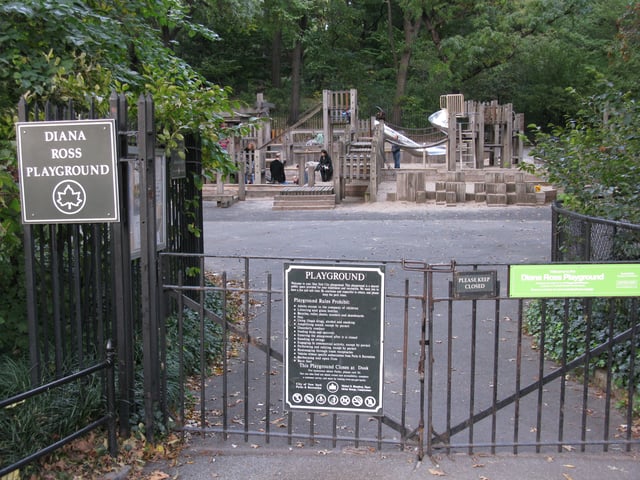
The Diana Ross Playground
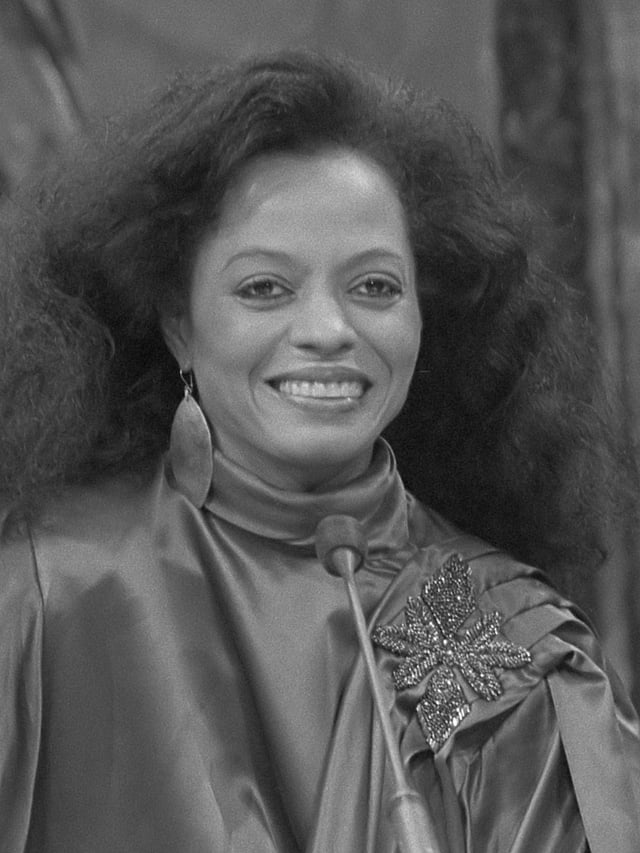
Ross in 1981
In October 1981, Ross released her first RCA album, Why Do Fools Fall in Love. The album sold over a million copies and featured hit singles such as her remake of the classic hit of the same name and "Mirror Mirror". Shortly thereafter, Ross established her production company, named Anaid Productions ("Diana" spelled backwards), and also began investing in real estate and touring extensively in the United States and abroad.
Before the release of Why Do Fools Fall in Love, Ross hosted her first TV special in four years, Diana. Directed by Steve Binder, the concert portions of the special were filmed at Inglewood, California's 17,500-seat The Forum indoor stadium and featured performances by Michael Jackson, Muhammad Ali, Dallas actor Larry Hagman, music impresario Quincy Jones and members of The Joffrey Ballet.[30][31]
On May 6, 1982, Ross was honored with a star on the Hollywood Walk of Fame.[34]
In 1982, she followed up the success of Why Do Fools Fall in Love with Silk Electric, which featured the Michael Jackson-written and -produced "Muscles", resulting in another top-ten success for Ross. The album eventually went gold on the strength of that song. In 1983, Ross ventured further out of her earlier soul-based sound for a more pop rock-oriented sound following the release of the Ross album. Though the album featured the top 40 hit single, "Pieces of Ice", the Ross album did not generate any more hits or achieve gold status.
On July 21, 1983, Ross performed a free concert on Central Park's Great Lawn, aired live worldwide by Showtime. Proceeds of the concert would be donated to build a playground in the singer's name. Midway through the beginning of the show, a torrential downpour began. Ross tried to continue performing, but, the severe weather required that the show be stopped after 45 minutes. Ross urged the large crowd to exit the venue safely, promising to perform the next day.
The second concert held the very next day was without rain. The funds for the playground were to be derived from sales of various memorabilia. However, they were destroyed by the storm. When the mainstream media discovered the exorbitant costs of the two concerts, Ross faced criticism from New York City's then-mayor Ed Koch and the city's Parks Department commissioner and poor publicity. During a subsequent mayoral press conference, Ross handed Koch a check for US$250,000 for the project.[35] The Diana Ross Playground was built three years later.[36]
In 1984, Ross released Swept Away. The album featured All of You, a duet with friend Julio Iglesias. The single was featured on both Ross' album and Iglesias' 1100 Bel Air Place, his first English-language album. It became an international hit, as did the Lionel Richie-penned ballad "Missing You", composed as a tribute to Marvin Gaye, who had died earlier that year. Swept Away garnered gold record sales status.
Her 1985 album, Eaten Alive, found major success overseas. "Chain Reaction" reached number one on the UK charts as well as in Australia and Ireland and the title track also performed well. Both songs had strong music videos that propelled the tracks to success. The Eaten Alive video was patterned after the 1960s horror film, The Island of Dr. Moreau while the "Chain Reaction" music video saluted the 1960s American Bandstand-style music shows. "Experience", the third international single's video reignited the "Eaten Alive" romantic storyline with Diana and actor Joseph Gian. The track, Eaten Alive, a collaboration with Barry Gibb and Michael Jackson, became a top 20 hit internationally.
The Barry Gibb-produced album garnered an international number one in "Chain Reaction" and a Top 20 selling album. It is believed Michael Finbarr Murphy, a distant cousin of Alan Murphy, guitarist for singer Kate Bush, Level 42 and others, played the guitar parts on "Chain Reaction". Michael was the producer for Unknown Quantity, the backing vocalists featured on the "Chain Reaction" track, are also featured as Ross' backing singers in the track's video. There were four members of Unknown Quantity, however, only 3 were needed for the video.
Earlier in 1985, Ross appeared as part of USA for Africa's '"We Are the World"' charity single, which sold over 20 million copies worldwide. Ross's 1987 follow-up to Eaten Alive, Red Hot Rhythm & Blues (No. 39 Billboard Top R&B Albums chart; No. 12 Sweden), found less success than the prior album. The accompanying acclaimed television special was nominated for three Emmy Awards, winning two (Outstanding Costume Design for a Variety or Music Program - Ray Aghayan and Ret Turner; Outstanding Lighting Direction (Electronic) for a Miniseries or a Special - Greg Brunton).[37][38]
In 1988, Ross chose to not renew her RCA contract, and had been in talks with her former mentor Berry Gordy to return to Motown. When she learned of Gordy's plans to sell Motown, Ross tried advising him against the decision though he sold it to MCA Records in 1988. Following the sale of the company, Ross was asked to return to the Motown label with the condition that she have shares in the company as a part-owner. Ross accepted the offer.
Ross' next album, 1989's Workin' Overtime was not a commercial success, despite the title track reaching the top three of the Billboard's Hot R&B/Hip-Hop Songs chart.[41] The album peaked at number 34 on the Billboard Hot R&B Albums chart, and achieved top 25 placings in Japan and the UK, attaining a silver certification in the latter country. Subsequent releases, such as The Force Behind the Power (1991), Take Me Higher (1995), and Every Day Is a New Day (1999) produced similar results. Ross's albums achieved more international than domestic success.
In 1991, Ross became one of the few American artists to have headlined the annual Royal Variety Performance, performing a selection of her UK hits before Queen Elizabeth II and Prince Philip, Duke of Edinburgh at the Victoria Palace Theatre, London.[42]
"The Force Behind the Power" sparked an international comeback of sorts when the album went double platinum in the UK.[43] led by the No. 2 UK hit single "When You Tell Me That You Love Me". The single's duet version with Irish group, Westlife, also hit No. 2 in the UK in 2005. The album performed well across Europe and into Japan as "The Force Behind the Power" achieved Gold record status in the nation. The album produced an astounding 9 singles across international territories, including another Top 10 hit, "One Shining Moment".
In 1994, One Woman: The Ultimate Collection, a career retrospective compilation, became a number one hit in the UK, selling quadruple platinum, and selling well across Europe and in the English-speaking world. The retrospective was EMI's alternative to Motown's box set Forever Diana: Musical Memoirs.
Ross performed during the Opening Ceremony of the 1994 FIFA World Cup held in Chicago and during the pre-match entertainment of the 1995 Rugby League World Cup final at Wembley Stadium.[44]
In May, 1996, Ross received the World Music Awards' Lifelong Contribution to the Music Industry Award.[47]
On November 29, 1996, EMI released the compilation album, Voice of Love, featuring the singles "In the Ones You Love", "You Are Not Alone" and "I Hear (The Voice of Love)".[48]
On February 8, 1997, EMI released the Japanese edition of Ross' album, A Gift of Love, featuring the single, "Promise Me You'll Try".[49]
In May, 1997, Ross performed with operatic tenors Placido Domingo and Jose Carreras again at the Superconcert of the Century concert, held in Taipei, Taiwan.[50]
On May 6, 1997, Ross inducted The Jackson 5 into The Rock & Roll Hall of Fame.[51]
On February 19, 1998, Ross hosted the Motown 40 telecast on ABC.[52]
In 1999, Ross was named the most successful female singer in the history of the United Kingdom charts, based upon a tally of her career hits. Madonna would soon succeed Ross as the most successful female artist in the UK. Later that year, Ross presented at the 1999 MTV Video Music Awards in September of the year and shocked the audience by touching rapper Lil' Kim's exposed breast, pasty-covered nipple, amazed at the young rapper's brashness.[53]
Supremes reunions, Return to Love and 2002 solo tour
Ross reunited with Mary Wilson first in 1976 to attend the funeral service of Florence Ballard, who had died in February of that year. In March 1983, Ross agreed to reunite with Wilson and Cindy Birdsong for the television special "Motown 25: Yesterday, Today, Forever". The Supremes did not rehearse their performance for that evening, due to time constraints. A scheduled medley of hits was cancelled.
Instead of following producer Suzanne dePasse's instructions to recreate their choreography from their final Ed Sullivan Show appearance, Wilson (according to her autobiography) planned with Birdsong to take a step forward every time Ross did the same, then began to sing lead on the group's final number-one hit song, "Someday We'll Be Together", on which Wilson did not perform.
Later, Wilson introduced Berry Gordy from the stage (unaware that the program's script called for Ross to introduce Gordy), at which point Ross subtly pushed down Wilson's hand-held microphone, stating, "It's been taken care of." Ross then re-introduced Gordy.[54][55] These moments were excised from the final edit of the taped special, but still made their way into the news media; People magazine reported that "Ross [did] some elbowing to get Wilson out of the spotlight."[56]
In 1999, Ross and mega-tour promoter SFX (which later became LiveNation) began negotiations regarding a Diana Ross tour which would include a Supremes segment. During negotiations with Ross, the promoters considered the creation of a Supremes tour, instead. Ross agreed. As the tour's co-producer, Ross invited all living former Supremes to participate. Neither Jean Terrell nor late 1970s member Susaye Greene chose to participate. 70s Supremes Lynda Laurence and Scherrie Payne were then touring as Former Ladies of the Supremes.
Ross contacted Mary Wilson and Cindy Birdsong, who then began negotiations with SFX. Negotiations with Wilson and Birdsong(who allowed Wilson to negotiate on her behalf) failed when Wilson refused SFX's and Ross' offer of $4 Million for 30 performances. Following the passage of SFX's final deadline for Wilson to accept their offer. Payne and Laurence, already negotiating with SFX, signed on to perform with Ross on the tour.
Laurence and Payne would later say that they got along well with Ross. The newly formed group performed together on The Today Show and The Oprah Winfrey Show, as well as VH1's Divas 2000: A tribute To Diana Ross. The Return to Love tour launched in June 2000, to a capacity audience in Philadelphia. The tour's final performance was at New York City's Madison Square Garden. The tour was cancelled by SFX shortly thereafter, due to mediocre ticket sales, despite glowing reviews from media as varied as Billboard magazine, The Detroit Free Press, the Los Angeles Times and The Village Voice newspapers.
On December 5, 2000, Ross received a Heroes Award from the National Academy of Recording Arts & Sciences (NARAS). The Heroes Award is the highest distinction bestowed by the New York Chapter.[57]
Diana Ross' first public post-RTL appearance was at a fundraiser for former President Bill Clinton. In January 2001, "Love & Life: The Very Best of Diana Ross" was released in the United Kingdom, becoming Ross' 17th gold album in that country. In June, Ross presented costume designer Bob Mackie with the Lifetime Achievement Award at the American Fashion Awards.
Two days before the 9/11 terrorist attacks, Ross performed "God Bless America" at the U.S. Open tennis championships before the tournament's women's final, between Venus and Serena Williams. Immediately following the attacks, Ross performed the song again at Shea Stadium, before the Mets first game, after driving cross-country to be with her children(In the wake of the attacks, flying in the U.S. was temporarily restricted.).[58] Ross teamed with legendary singers Patti LaBelle, Eartha Kitt among others for a Nile Rodgers-produced recording of Sister Sledge's classic disco hit, "We Are Family", recorded to benefit the families of 9/11 victims.
In May 2002, Ross and all five of her children appeared on Barbara Walters' Mother's Day television special. Shortly thereafter, Ross admitted herself into the 30-day substance abuse program at the Promises Institute in Malibu, California, after friends and family began to notice a burgeoning alcohol problem. Ross left the program three weeks later, and began to fulfill previously scheduled concert dates, beginning with a performance before a 60,000-strong crowd at London's Hyde Park, for Prince Charles' Prince's Trust charity.
U.S. ticket sales for the new tour were brisk, from coast to coast. Venues such as Long Island, New York's Westbury Music Fair and California's Cerritos Center for the Performing Arts and Humphrey's Concerts by the Bay attempted to add extra shows, due to public demand. Sold-out performances in Boston and Ontario, Canada, followed. In August, shortly after the tour began, however, Ross re-entered the Promises Institute's substance abuse rehabilitation program. That December, during her stay at Arizona's Canyon ranch Health Resort, Ross was pulled over by Tucson police for driving the wrong way on a one-way street. She failed a breathalizer test and was arrested for a DUI. Ross was later sentenced to 48 hours in jail, which she served near her home in Greenwich, Connecticut.
In January 2003, Ross was honored as Humanitarian of the Year by Nile Rodgers' We Are Family Foundation. Shortly thereafter, Ross was feted as an honored guest at the National Association of Black-Owned Broadcasters Awards. Later that year, Ross was the guest performer at that year's Metropolitan Museum of Art's Costume Institute's annual gala, in an ensemble custom-designed by designer Tom Ford, followed by an appearance as the surprise celebrity model for American couturier Dennis Basso's runway show.
In February, 2003, The Supremes were honored by The Rhythm & Blues Foundation honored The Supremes with its Pioneer Award.[59]
Later career: 2004–present
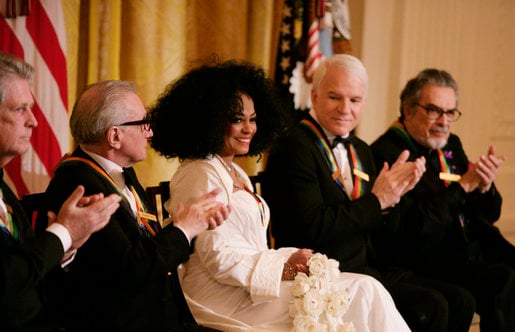
Diana Ross is applauded by her fellow Kennedy Center honorees as she is recognized for her career achievements by President George W. Bush in the East Room of the White House Sunday, December 2, 2007, during the Kennedy Center Gala Reception. From left to right: singer-songwriter Brian Wilson; filmmaker Martin Scorsese; Ross; comedian, actor and author Steve Martin, and pianist Leon Fleisher.
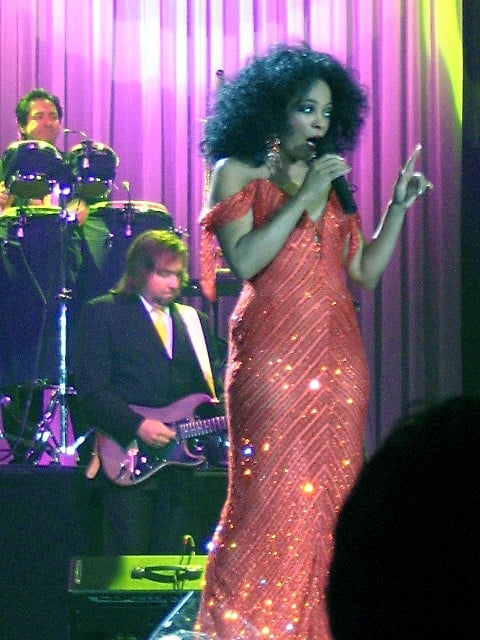
Diana Ross in concert in Rotterdam, 2007
On January 14, 2005, Ross performed at the Tsunami Aid: A Concert of Hope TV concert to help raise money for Indonesian tsunami victims.[62] On January 20, 2005, Ross launched her M.A.C. Icon makeup collection, as part of the beauty corporation's Icon Series.[63] In 2005, Ross participated in Rod Stewart's Thanks for the Memory: The Great American Songbook, Volume IV recording a duet version of the Gershwin standard, "I've Got a Crush on You". The song was released as promotion for the album and later reached number 19 on the Billboard Hot Adult Contemporary chart, marking her first Billboard chart entry since 2000.[64] Ross was featured in another hit duet, this time with Westlife, on a cover of Ross's 1991 hit "When You Tell Me You Love Me", repeating the original recording's chart success, garnering a number 2 UK Singles Chart hit (number 1 in Ireland).
Also in 2005, Ross was featured as an honored guest at Oprah Winfrey's Legends Ball Weekend, a three-day celebration honoring 25 African-American women in art, entertainment and civil rights. On May 22, 2006, a year after the celebration, a one-hour program about the weekend aired on ABC, including celebrity interviews and behind-the-scenes moments.[65] On March 22, 2006, Ross' televised Central Park concerts, entitled "For One & for All", are named TV Land Awards' Viewer's Choice for Television's Greatest Music Moment.[66]
In June 2006, Universal released Ross's shelved 1972 Blue album. It peaked at number two on Billboard's jazz albums chart.[67] Later in 2006, Ross released her first studio album in seven years with I Love You. It would be released on EMI/Manhattan Records in the United States in January 2007.[68] EMI Inside later reported the album had sold more than 622,000 copies worldwide. "I Love You" peaked at No. 32 on Billboard's Hot 200 albums chart[69] and No. 16 on Billboard's Top R&B Albums chart. Ross later ventured on a world tour to promote I Love You. In 2007, Ross was honored with the BET Awards' Lifetime Achievement Award and, later, as one of the honorees at the Kennedy Center Honors.
In October 2009, Ross was the featured performer at the annual "Symphonica in Rosso" concert series, held at the GelreDome Stadium in Arnhem, Netherlands.[74]
In 2010, Ross embarked on her first headlining tour in three years titled the More Today Than Yesterday: The Greatest Hits Tour. Dedicated to the memory of her late friend Michael Jackson, the concert tour garnered positive reviews, nationwide.[75]
In 2011, Diana Ross was inducted into the Michigan Rock and Roll Legends Hall of Fame.[76]
In February 2012, Ross received her first Grammy Award, for Lifetime Achievement, and announced the nominees for the Album of the Year.[2] In May, a DVD of her Central Park concert performances, For One & For All, was released and featured commentary from Steve Binder, who directed the special. A month later, on December 9, she performed as the marquee and headlining performer at the White House-hosted Christmas in Washington concert, where she performed before President Barack Obama. The event was later broadcast as an annual special on TNT. In 2013, Ross completed a tour in South America and a tour in the United States. On July 3, 2014, Ross was awarded the Ella Fitzgerald Award for "her extraordinary contribution to contemporary jazz vocals", at the Festival International de Jazz de Montréal. On November 20, 2014, Ross presented the Dick Clark Award for Excellence to Taylor Swift at the American Music Awards.
In 2015, Ross appeared in the video for the song "How to Live Alone" performed by her son Evan Ross. On April 1, 2015, Ross began the first of nine performances as a part of her mini-residency, The Essential Diana Ross: Some Memories Never Fade at The Venetian in Las Vegas, Nevada.[77][78] On November 27, 2015, Motown Records/Universal released the album Diana Ross Sings Songs from The Wiz, recorded in 1978. The album features Ross' versions of songs from the film version of the musical The Wiz, in which she starred along with Michael Jackson, Nipsey Russell, Ted Ross, Richard Pryor and Lena Horn.
In February 2016, Ross resumed her In the Name of Love Tour, which began in 2013. On November 22, 2016, Ross was awarded the Presidential Medal of Freedom by President Obama.[79]
On June 30, 2017, Ross headlined the Essence Festival in New Orleans, Louisiana, with her daughter Rhonda Ross-Kendrick performing as the opening act.[80][81] On November 19, 2017, Ross received the American Music Awards Lifetime Achievement Award.[82] Ross performed several of her hits, ending with "Ain't No Mountain High Enough", during which she brought all of her grandchildren onstage. Her eldest grandson, eight-year-old Raif-Henok Emmanuel Kendrick, son of Rhonda Ross-Kendrick and husband, Rodney, performed an impromptu dance behind Ross, which gained attention.[83] Ross was then joined onstage by all of her children, their spouses, first ex-husband Robert Ellis, Smokey Robinson (who brought Ross to Motown) and Motown founder, Berry Gordy.
In December 2017, Ross appeared on the Home Shopping Network to promote her first fragrance, Diamond Diana.[84] The fragrance sold out within hours. Ross made several hour-long appearances on the network, and also released a tie-in CD retrospective collection of her music entitled Diamond Diana. Diamond Diana peaked at number six on the Billboard R&B Albums chart[85] and number five on its Top Album Sales chart.[86] The CD's first single release, "Ain't No Mountain High Enough 2017", remixed by Eric Kupper, reached number one on the Billboard Dance Club Songs chart.[87]
On February 8, 2018, Ross began a new mini-residency at The Wynn Las Vegas Hotel & Casino.[88] On August 4, 2018, Ross scored another No. 1 hit on Billboard's Top Dance Chart with "I'm Coming Out/Upside Down 2018"[89] She performed a song from a to be released compilation Christmas album at Macy's Annual Thanksgiving parade on November 22, 2018 [90]
On February 10, 2019, the Recording Academy honored Ross at the 61st Annual Grammy Awards.[91] Ross performed "The Best Years of My Life" and "Reach Out and Touch (Somebody's Hand)". In 2019 her song "The Boss" was remixed by Eric Kupper as "The Boss 2019", and reached number one on Billboard's Top Dance Chart on April 13.[92]
Personal life
Relationships and family
Ross has been married twice and has five children.
In 1965, Ross became romantically involved with Motown CEO Berry Gordy. The relationship lasted several years, resulting in the birth of Ross's eldest child, Rhonda Suzanne Silberstein, in August 1971. Two months into her pregnancy with Rhonda, in January 1971, Ross married music executive Robert Ellis Silberstein,[93] who raised Rhonda as his own daughter, despite knowing her true paternity. Ross told Rhonda that Gordy was her biological father when Rhonda was 13 years old. Beforehand, Rhonda referred to Gordy as "Uncle B.B."
Ross has two daughters with Silberstein, Tracee Joy and Chudney Lane Silberstein, born in 1972 and 1975, respectively.[94] Ross and Silberstein divorced in 1977,[95] and Ross moved to New York City in the early 1980s, after living in Los Angeles since Motown relocated to the area in the early 1970s.
Ross dated Gene Simmons, bass guitarist and singer for the band Kiss, from 1980 to 1983.[96] They began dating after Cher, who had remained friends with Simmons following their break-up, suggested he ask Ross to help him choose her Christmas present. Simmons, in his autobiography, contends that he was not dating Cher when he met Ross. Ross ended her relationship with Simmons when he gave Ross the erroneous impression that he had resumed his relationship with Cher. Simmons' story differed in 2015 when he revealed that he fell in love with Ross while dating Cher, which ended Ross and Cher's friendship.[97]
Ross met her second husband, Norwegian shipping magnate Arne Næss Jr., in 1985, and married him the following year. She became stepmother to his three elder children; Katinka, Christoffer, and folk singer Leona Naess. They have two sons together: Ross Arne (born in 1987) and Evan Olav (born in 1988). Ross and Næss divorced in 2000, after press reports revealed that Naess had fathered a child with another woman in Norway.[98] Ross considers Næss the love of her life.[99] Næss fell to his death in a South African mountain climbing accident in 2004.[100] Ross remains close with her three ex-stepchildren.
Ross has five grandchildren: grandson Raif-Henok (born in 2009 to her daughter Rhonda); grandsons Leif (born on June 5, 2016) and Idingo (born 2017), born to her son Ross Næss[101]; and granddaughters Callaway Lane (born in 2012 to Ross's daughter Chudney) and Jagger Snow (born in 2015 to Ross's son Evan).[102][103]
Religious views
Diana Ross considers herself a Baptist.[104] She used to sing in a church, where she gained her initial musical experience.[105] Her mother Ernestine's father, Reverend William Moten, served as a pastor in the Bessemer Baptist Church in Bessemer, Alabama. The Ross children spent considerable time with their maternal grandparents during their mother's bouts with tuberculosis.[106]
2002 arrest
Legacy
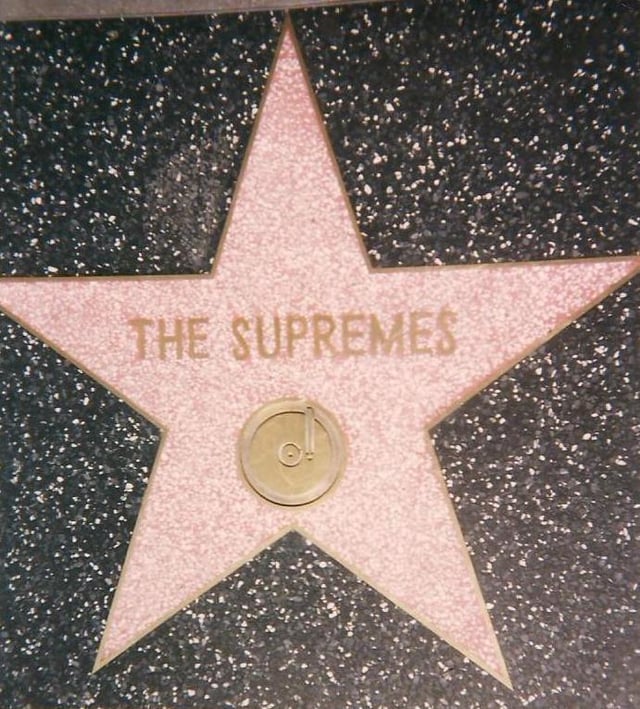
In 1994, the Supremes were recognized with a star on Hollywood Walk of Fame at 7060 Hollywood Blvd. Apart from this star, Ross has one for her individual work.
Various works have been inspired by Ross's career and life. The character of Deena Jones in Dreamgirls was inspired by Ross.[114]
Several of Ross's songs have been covered and sampled. "Ain't No Mountain High Enough" has been featured in the film Chicken Little. The song has also been covered live and on albums by Jennifer Lopez, Amy Winehouse. Janet Jackson sampled "Love Hangover" on her 1997 song "My Need" (featured on the album The Velvet Rope), having already sampled "Love Child" and "Someday We'll Be Together" by Ross & the Supremes on her 1993 tracks "You Want This" and "If" (both released as singles from the janet. album). "Love Hangover" was also sampled in Monica's 1998 number 1 "The First Night" as well as being sampled by Will Smith, Master P (who also sampled "Missing You"), Heavy D and Bone Thugs N Harmony, "It's Your Move" was sampled in 2011 by Vektroid for her song "Lisa Frank 420 / Modern Computing", which appeared in her ninth album Floral Shoppe under her one-time alias Macintosh Plus.
Motown: The Musical is a Broadway musical that launched on April 14, 2013. It is the story of Berry Gordy's creation of Motown Records and his romance with Diana Ross.
As a member of the Supremes, her songs "Stop! In the Name of Love" and "You Can't Hurry Love" are among the Rock and Roll Hall of Fame's 500 Songs that Shaped Rock and Roll.[115] They were inducted into the Rock and Roll Hall of Fame in 1988, received a star on the Hollywood Walk of Fame in 1994, and entered into the Vocal Group Hall of Fame in 1998. In 2004, Rolling Stone placed the group at number 96 on their list of the "100 Greatest Artists of All Time".[116]
As lead singer of the Supremes and as a solo artist, Ross has earned 18 number-one singles (12 as lead singer of the Supremes and 6 as a solo artist). While Mariah Carey is the only solo female artist to have 18 number-one U.S. singles, Ms. Ross is the only female artist to have number one singles as a solo artist; as the other half of a duet (Lionel Richie); as a member of a trio (the Supremes); and, as an ensemble member (We are the World-USA for Africa). Ross was featured on the Notorious B.I.G.'s 1997 number-one hit, "Mo Money Mo Problems" as her voice from her 1980 hit, "I'm Coming Out", was sampled for the song.
Billboard magazine named Ross the "female entertainer of the century" in 1976. In 1993, she earned a Guinness World Record, due to her success in the United States and United Kingdom for having more hits than any other female artist in the charts with a career total of 70 hit singles. Ross is also one of the few recording artists to have two stars on the Hollywood Walk of Fame—one as a solo artist and the other as a member of the Supremes. After her 1983 concert in Central Park, Diana Ross Playground was named in her honor with a groundbreaking opening ceremony in 1986.
Ross was given credit for the discovery of the Jackson 5. Her "discovery" was simply part of Motown's marketing and promotions plan for the Jackson 5. Consequently, their debut album was titled Diana Ross Presents the Jackson 5. It was actually Motown producer Bobby Taylor who discovered the Jacksons.[117] Even so, Ross embraced the role and became a good friend of Michael Jackson, serving as a mother figure to him.[118]
In 2006, Diana was one of 25 African-American women saluted at Oprah Winfrey's Legends Ball, a three-day celebration, honoring their contributions to art, entertainment, and civil rights.
Diana Ross was named one of the Five Mighty Pop Divas of the Sixties along with Dusty Springfield, Aretha Franklin, Martha Reeves, and Dionne Warwick.
Awards and nominations
On November 16, 2016, Ross was announced as one of the 21 recipients of the Presidential Medal of Freedom, the nation's highest civilian honor.[119]
Discography
Studio albums
Diana Ross (1970)
Everything Is Everything (1970)
Surrender (1971)
Touch Me in the Morning (1973)
Diana & Marvin (with Marvin Gaye) (1973)
Last Time I Saw Him (1973)
Diana Ross (1976)
Baby It's Me (1977)
Ross (1978)
The Boss (1979)
Diana (1980)
Why Do Fools Fall in Love (1981)
Silk Electric (1982)
Ross (1983)
Swept Away (1984)
Eaten Alive (1985)
Red Hot Rhythm & Blues (1987)
Workin' Overtime (1989)
The Force Behind the Power (1991)
A Very Special Season (1994)
Take Me Higher (1995)
Every Day Is a New Day (1999)
Blue (2006)
I Love You (2006)
Soundtrack albums
Diana! (1971)
Lady Sings the Blues (1972)
Mahogany (1975)
The Wiz (1978)
Endless Love: Original Motion Picture Soundtrack (1981)
Live albums
Live at Caesars Palace (1974)
An Evening with Diana Ross (1977)
Greatest Hits Live (1989)
Stolen Moments: The Lady Sings... Jazz and Blues (1993)
Christmas in Vienna (with Plácido Domingo and José Carreras) (1993)
Filmography
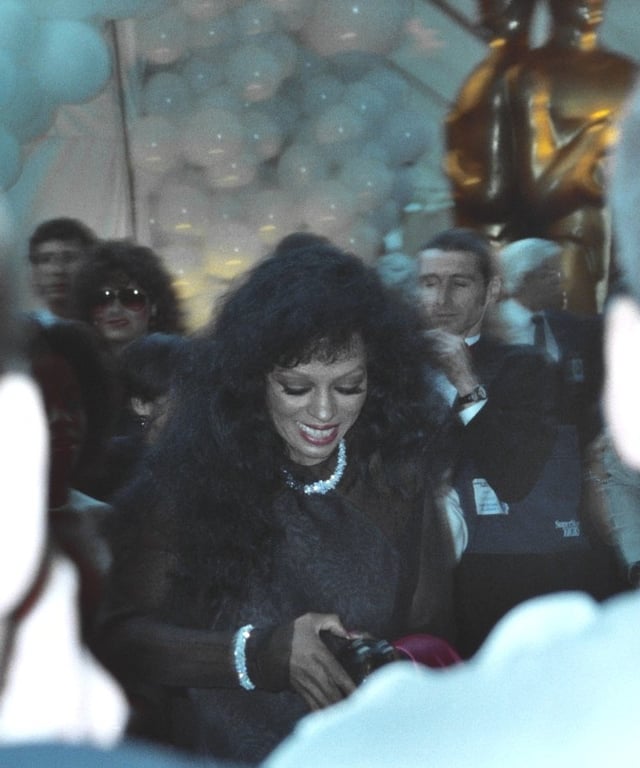
Diana Ross at the Academy Awards in 1990
Lady Sings the Blues (1972)
Mahogany (1975)
The Wiz (1978)
Out of Darkness * (1994)
Double Platinum * (1999)
(* = made directly for television)
Television
T.A.M.I. Show (with the Supremes) (1964)
Tarzan (with the Supremes) (1968)
TCB (with the Supremes) (1968)
The Dinah Shore Special: Like Hep (with Dinah Shore and Lucille Ball) (1969)
G.I.T. on Broadway (with the Supremes and the Temptations) (1969)
Diana! (1971)
The Jackson 5ive (1971)
Make Room for Granddaddy (1971)
Here I Am: An Evening with Diana Ross (1977)
The Muppet Show (1977)
Standing Room Only (HBO) (1980)
Diana! (TV Special) (1981)
Motown 25: Yesterday, Today, Forever (1983)
Diana Ross: Live in Central Park/For One and For All (Showtime) (1983)
Diana Ross: Red Hot Rhythm and Blues (1987)
Diana Ross: Workin' Overtime HBO: World Stage (1989)
Diana Ross Live! The Lady Sings... Jazz & Blues: Stolen Moments (1992)
Christmas in Vienna (1992)
BET Walk of Fame (1993)
Always is Forever: 30th Anniversary (1993)
1994 FIFA World Cup (1994)
Super Bowl XXX (1996)
Super Concert of the Century (1997)
An Audience with Diana Ross (1999)
VH1 Divas 2000: A Tribute to Diana Ross (2000)
The Making and Meaning of We Are Family (documentary) (2002)
Tsunami Aid (2005)
BET Awards 2007 (2007)
Kennedy Center Honors (2007)
Nobel Peace Prize Concert (2008)
Christmas in Washington (2012)
The Voice (2014)
HSN (2017)
Ashlee+Evan (2018)
Stage
An Evening with Diana Ross (1976)
Tours
Headlining
The Diana Ross Show (1970–1975)
An Evening with Diana Ross (1976–1978)
Diana Ross Tour (1978–1981)
Diana Ross on Tour (1982)
Up Front Tour (1983)
Missing You Tour (1984)
Eaten Alive Tour (1985–1988)
Workin' Overtime World Tour (1989)
Here & Now Tour (1991–1992)
Forever Diana! World Tour (1993–1994)
Take Me Higher Tour (1995–1996)
Voice of Love Tour (1997–1998)
Always is Forever Tour (1999)
Live Love Tour (2004)
This is It Tour (2004)
I Love You Tour (2006–2008)
More Today Than Yesterday: The Greatest Hits Tour (2010–2011)
In the Name of Love Tour (2013–2017)
Endless Memories (2018)
Brand New Day Tour (2019)
Co-headlining tours
Superconcert of the Century (with Placido Domingo and Jose Carreras) (1997)
Return to Love Tour (with former members of the Supremes) (2000)
Residency shows





























